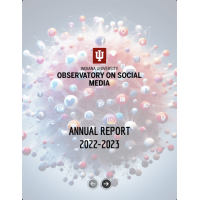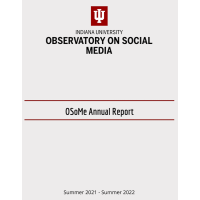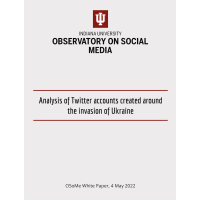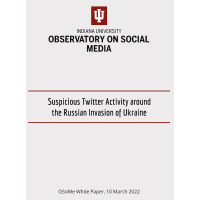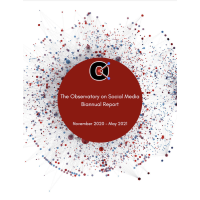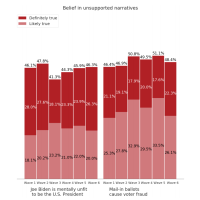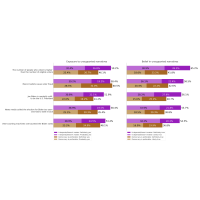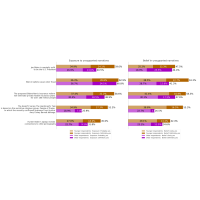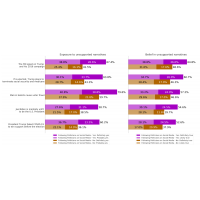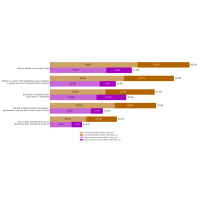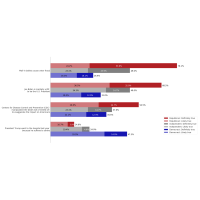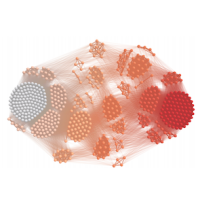White Papers
🔗OSoMe Annual Report: 2022 - 2023
In our third annual report, published in late Fall 2023, we provide highlights of the many activities of the Observatory during the academic year 2022-2023, roughly, as well as updates on the growing OSoMe team.
🔗OSoMe Annual Report: Summer 2021 - Summer 2022
In our second annual report, published in Fall 2022, we provide updates on the Observatory's team, research, tools, teaching, visitors, grants, and impact during the academic year 2021-2022.
🔗Analysis of Twitter accounts created around the invasion of Ukraine
Russia launched a full-scale military invasion of Ukraine on February 24, 2022. During the early weeks of the invasion it became clear that the war was also fought in the arena of public opinion, around the world. In our previous work we reported on a sharp increase in the number of new accounts created in the first days after the invasion, and on multiple groups of accounts sharing suspiciously similar messages. In this analysis, we focus on accounts created during the first week of the Russian invasion, when new account creation was at its peak. We are motivated by the hypothesis that newer accounts are more likely to be inauthentic. For instance, these new accounts could include automated and sock-puppet accounts put in place to coordinate campaigns and manipulate online conversations. Preliminary analysis about the spike in the creation of new accounts around the date of the invasion does not demonstrate evidence of a substantial Russian incursion into the Twittersphere.
🔗Suspicious Twitter Activity around the Russian Invasion of Ukraine
On February 24, 2022, Russia began a full-scale military invasion of Ukraine. The global scale of national interests related to the invasion means that public opinion in many countries is likely to play a significant role in the conflict. In turn, social media can play a key role in shaping public opinion in geopolitical events. Consequently, the potential to exploit social vulnerabilities through social media is of great concern. Detecting and monitoring these kinds of abuse is part of our mission at the Observatory on Social Media. We present some preliminary results about a dramatic spike in the creation of new accounts around the date of the invasion, and about several networks of accounts sharing suspiciously similar content.
🔗OSoMe Annual Report: November 2020 - May 2021
In our first annual report, published in Spring 2021, we provide updates on the Observatory's research, collaborations, and externally-funded projects and partnerships during the academic year 2020-2021.
🔗Tracking Public Opinion About Unsupported Narratives in the 2020 Presidential Election - Wave 8 Report
Indiana University’s Observatory on Social Media (OSoMe) continues to track widely circulated but unsupported narratives in public discourse, with the goal to assess the public’s awareness of them, the extent to which they are believed, and whether a person’s political leanings, media use, and personal traits are related to vulnerability to these narratives. The first six waves were pre-election surveys. This is a report on our 8th wave of data, collected post-election.
Wave 8 (Jul 20 - Aug 3, 2021): Data
🔗Tracking Public Opinion About Unsupported Narratives in the 2020 Presidential Election - Wave 7 Report
Indiana University’s Observatory on Social Media (OSoMe) continues to track widely circulated but unsupported narratives in public discourse, with the goal to assess the public’s awareness of them, the extent to which they are believed, and whether a person’s political leanings, media use, and personal traits are related to vulnerability to these narratives. The first six waves were pre-election surveys. This is a report on our 7th wave of data, collected post-election.
Wave 7 (June 6 - 14, 2021): Data
🔗Tracking Public Opinion About Unsupported Narratives in the 2020 Presidential Election - Final Summary of First 6 Waves
OSoMe periodically engages in survey work to examine audience and user trends in relation to social media. All elections feature claims and counterclaims by contending parties. The 2020 election seems to be an especially salient example, as conspiracy theories and a variety of misleading narratives, many of which can be debunked with professional fact-checking, are rampant. Our team tracked widely circulated narratives throughout the 2020 election, with the goal to assess the public’s awareness of them, the extent to which they are believed, and whether one’s political leaning is related to vulnerability to these narratives.
Here we summarize the results of the first six waves.
🔗Tracking Public Opinion About Unsupported Narratives in the 2020 Presidential Election - Wave 6 Report
OSoMe periodically engages in survey work to examine audience and user trends in relation to social media. All elections feature claims and counterclaims by contending parties. The 2020 election seems to be an especially salient example, as conspiracy theories and a variety of misleading narratives, many of which can be debunked with professional fact-checking, are rampant. Our team tracked widely circulated narratives throughout the 2020 election, with the goal to assess the public’s awareness of them, the extent to which they are believed, and whether one’s political leaning is related to vulnerability to these narratives.
Wave 6 (Nov 18 - 27, 2020): Data
🔗Tracking Public Opinion About Unsupported Narratives in the 2020 Presidential Election - Wave 5 Report
OSoMe periodically engages in survey work to examine audience and user trends in relation to social media. All elections feature claims and counterclaims by contending parties. The 2020 election seems to be an especially salient example, as conspiracy theories and a variety of misleading narratives, many of which can be debunked with professional fact-checking, are rampant. Our team tracked widely circulated narratives throughout the 2020 election, with the goal to assess the public’s awareness of them, the extent to which they are believed, and whether one’s political leaning is related to vulnerability to these narratives.
Wave 5 (Oct 27 - Nov 2, 2020): Data
🔗Tracking Public Opinion About Unsupported Narratives in the 2020 Presidential Election - Wave 4 Report
OSoMe periodically engages in survey work to examine audience and user trends in relation to social media. All elections feature claims and counterclaims by contending parties. The 2020 election seems to be an especially salient example, as conspiracy theories and a variety of misleading narratives, many of which can be debunked with professional fact-checking, are rampant. Our team tracked widely circulated narratives throughout the 2020 election, with the goal to assess the public’s awareness of them, the extent to which they are believed, and whether one’s political leaning is related to vulnerability to these narratives.
Wave 4 (Oct 15 - 24, 2020): Data
🔗Tracking Public Opinion About Unsupported Narratives in the 2020 Presidential Election - Wave 3 Report
OSoMe periodically engages in survey work to examine audience and user trends in relation to social media. All elections feature claims and counterclaims by contending parties. The 2020 election seems to be an especially salient example, as conspiracy theories and a variety of misleading narratives, many of which can be debunked with professional fact-checking, are rampant. Our team tracked widely circulated narratives throughout the 2020 election, with the goal to assess the public’s awareness of them, the extent to which they are believed, and whether one’s political leaning is related to vulnerability to these narratives.
Wave 3 (Oct 2 - 13, 2020): Data
🔗Tracking Public Opinion About Unsupported Narratives in the 2020 Presidential Election - Wave 2 Report
OSoMe periodically engages in survey work to examine audience and user trends in relation to social media. All elections feature claims and counterclaims by contending parties. The 2020 election seems to be an especially salient example, as conspiracy theories and a variety of misleading narratives, many of which can be debunked with professional fact-checking, are rampant. Our team tracked widely circulated narratives throughout the 2020 election, with the goal to assess the public’s awareness of them, the extent to which they are believed, and whether one’s political leaning is related to vulnerability to these narratives.
Wave 2 (Sep 9 - 26, 2020): Data
🔗Tracking Public Opinion About Unsupported Narratives in the 2020 Presidential Election - Wave 1 Report
OSoMe periodically engages in survey work to examine audience and user trends in relation to social media. All elections feature claims and counterclaims by contending parties. The 2020 election seems to be an especially salient example, as conspiracy theories and a variety of misleading narratives, many of which can be debunked with professional fact-checking, are rampant. Our team tracked widely circulated narratives throughout the 2020 election, with the goal to assess the public’s awareness of them, the extent to which they are believed, and whether one’s political leaning is related to vulnerability to these narratives.
Wave 1 (Aug 20 - Sep 7, 2020): Data

